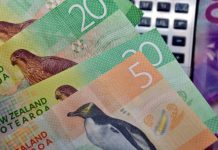Dollar gains as Fed signals possible rate hike
Financial markets experienced the consequences of a communication failure overnight, which will be felt equally, if not worse, in Asia today. The Federal Reserve’s FOMC meeting held a nasty surprise for investors; the dot plots of future rate hikes abruptly shifted forward en masse to 2023. And Fed Chairman Jerome Powell said that the time was coming for a talk about starting to talk about beginning to talk about quantitative easing tapering.
Mr Powell’s pleas to take the abrupt shift in the dot plots “with a grain of salt” fell on deaf airs as US yields rose, the US dollar spiked, equities fell, while gold and bitcoin were stretchered off injured. With Fed officials having spent the weeks and months ahead of last night’s FOMC meeting beating the inflation is transitory, it’s all about the labour market, nothing to see here, move along mantra, the FOMC really did spoof financial markets overnight.
I am wondering if Chairman Powell was blindsided by the FOMC members himself, which makes the whole situation even worse. The FOMC minutes will make fascinating reading this time around because dissension in the ranks will make the entire surprise overnight look even worse.
In a world that has become addicted to bottomless amounts of zero per cent money from the world’s central banks over the last 12 years, and even more so over the past year, I have always doubted a taper-tantrum sequel could be avoided. It was always just a case of how bad the tantrum would be. The price action in Asia today suggests nervously cautious rather than a panicked charge for the exit door. I would suggest that sentiment is fragile, though. Buying the dip has worked handsomely over the past year, and I have no doubt the buy-the-dippers will be out today. Things could be different this time, though, and rather than trying to catch a falling boulder, buying on the way back up, if that is how it plays out, could be the wiser strategy.
If indeed we are reaching peak asset price inflation, much of Asia could be left in a conundrum. Apart from the yield-seeking oceans of capital that have reached into the furthermost corners of Asia’s financial markets, which might start looking unappealing and suddenly less liquid, much of Asia is out of sync with the US recovery and potentially its monetary policy.
If US yields rise, lifting the US dollar ever higher, those implied dirty pegs to the greenback will come under stress. Especially so because interest rates in Asia at rock bottom levels as well. You can either burn through your foreign reserves and sell US dollars, of which, admittedly, Asia has accumulated an enormous war chest. Or you can lift interest rates to defend your currency.
The problem with much of Asia and ASEAN is that they are not yet ready to begin tightening as much of the region is still unvaccinated and marking time for better times ahead. The last thing they need right now is higher rates. If the shift in FOMC tone leads to an ongoing reversal of the buy-everything trade, Asian bonds, equities, and currencies could come under sustained pressure. The long-forgotten adage of an emerging market being a market you can’t emerge from in an emergency still holds true.
Taiwan and Indonesia’s central banks announce their latest policy decisions today, and Japan does tomorrow. All three will remain unchanged but will now have food for thought. Of the three, Indonesia faces the biggest conundrum going forward if we have seen peak-Fed. With a large amount of foreign-denominated debt and still weak domestic demand, the last thing the Bank of Indonesia needs right now is to contemplate higher future rates to protect the rupiah. Covid-19 cases are rising here as well after the Eid holiday, with more robust control measures a possibility. Indonesia, Malaysia, the Philippines, Thailand and India won’t look special in this scenario, although India has accumulated enormous foreign reserves to buffer any pain.
Both the Australian and New Zealand currencies were sold heavily overnight as proxies for risk-sentiment and Asia. But both have earned a respite this morning after impressive data releases. New Zealand Q1 GDP blew forecasts out of the water with the data showing a broad-based recovery, tourism and Auckland lockdowns aside. Australian Employment for May staged an equally impressive rebound after a soft April. Employment rose by 115,200 jobs, and more importantly, full-time jobs rose by 97,500. Ominously, the yield curves in both Antipodeans firmed post-FOMC, highlighting the reach of the Fed. Higher yields and impressive data may only provide a temporary reprieve for the currencies.
Singapore Q1 Unemployment fell to 2.90% today, while its May Trade Balance rose to USD5.754 billion. Singapore Inc’s export sector continues to underpin the city-state recovery, but the domestic demand is murkier. Singapore is in Covid-19 restrictions at the moment. Yesterday, the government said it was reassessing the reopening schedule thanks to the elusiveness of the virus this time around. Therefore, the positive data is unlikely to give Singapore equities much of a tailwind.
China announced more measures to control commodity prices yesterday, including releasing essential industrial metals from its strategic reserves onto the domestic market. As a net importer of basically everything, a semi-disguised buyers strike will only delay the outcome of a battle it can’t win. Nevertheless, it was enough to send metal prices tumbling yesterday, notably copper.
Following on from its intervention in big-tech, an anti-trust probe into Didi Chuxing is apparently imminent, virtual currencies and shadow banking. Thus, it appears that China is becoming more interventionist and less free-market for the foreseeable future. It also suggests that the leadership has deeper concerns about China’s recovery and leverage in the economy. Whether that shifts the PBOC from its liquidity tightening stance is too soon to say, but China equities are likely to lag for a while, especially if the FOMC language change takes root globally.













